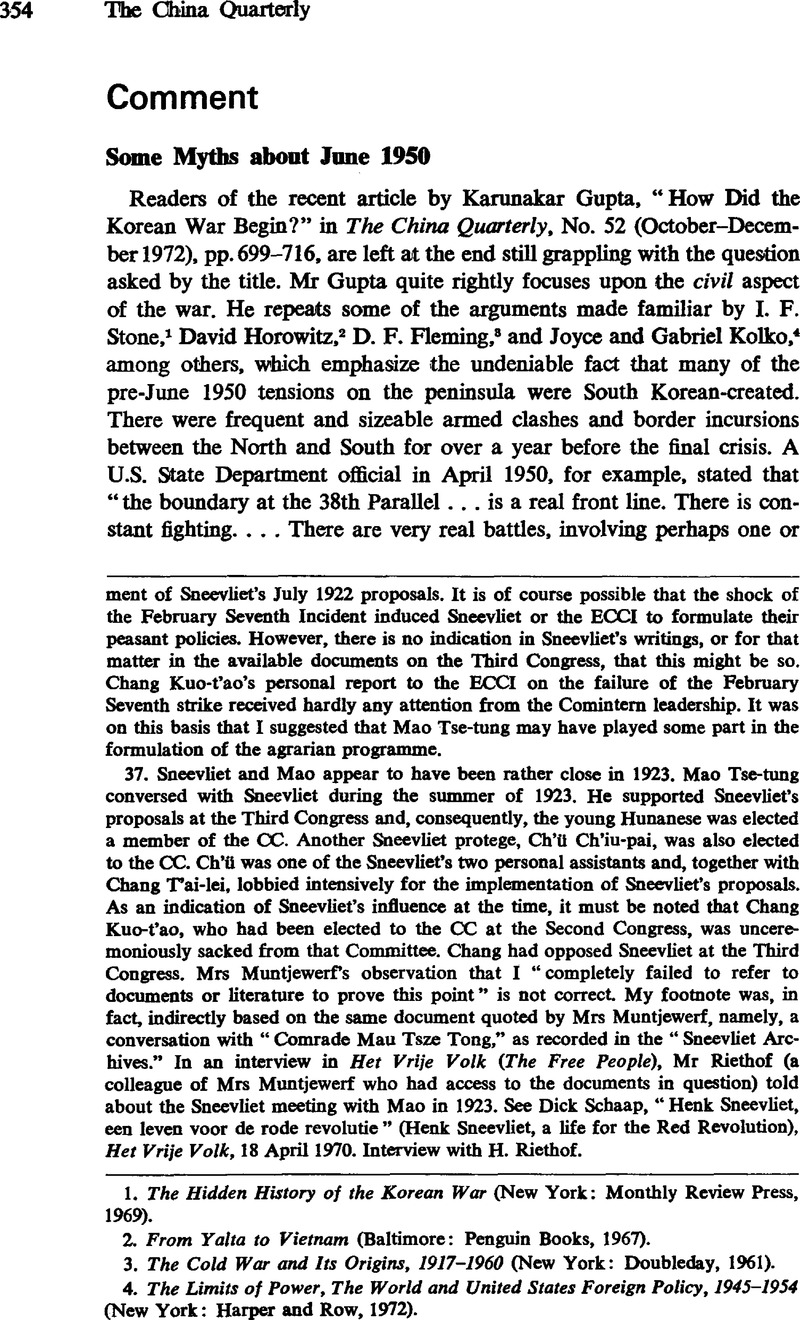No CrossRef data available.
Article contents
Some Myths about June 1950
Published online by Cambridge University Press: 17 February 2009
Abstract

- Type
- Comment
- Information
- Copyright
- Copyright © The China Quarterly 1973
References
1. The Hidden History of the Korean War (New York: Monthly Review Press, 1969)Google ScholarPubMed;
2. From Yalta to Vietnam (Baltimore: Penguin Books, 1967)Google Scholar;
3. The Cold War and Its Origins, 1917–1960 (New York: Doubleday, 1961)Google Scholar;
4. The Limits of Power, The World and United States Foreign Policy, 1945–1954 (New York: Harper and Row, 1972)Google Scholar;
5. Jessup, Phillip in The Department of State Bulletin, 24 04 1950, p. 627Google Scholar;
6. Hanguk Chonjaeng-sa (History of the Korean War), Vol II (Seoul: War History Compilation Committee, 1969), pp. 87–94, and 219–23Google Scholar; The History concluded that the claimed attack onHaeju, “was a completely exaggerated false report contrary to the facts” (p. 221)Google Scholar; [For a translation of what the History says about how the report of an attack occurred, see note 1 of Professor Lee's comment below.—Editor.]
7. “Counter Attack On,” New York Times, 26 June 1950.
8. Appleman, Roy E., South to the Naktong, North to the Yalu (Washington: Office of the Chief of Military History, 1961), p. 22Google Scholar;
9. Ibid.
10. Ibid. p. 18.
11. A Preliminary Study of the Impact of Communism Upon Korea (Maxwell Air Force Base: U.S. Air Force, 05 1951), pp. 38–40Google Scholar;
12. See Kolko, and Kolko, , The Limits of Power, pp. 570–5Google Scholar;
13. Jervis, Robert, “Hypotheses on Misperception,” World Politics, 10 1968, p. 455Google Scholar;
14. Simmons, Robert R., “The Korean Civil War,” in Baldwin, Frank (ed), Without Parallel: Essays on American-Korean Relations Since 1945 [tentative title] (New York, Pantheon BooksGoogle Scholar; forthcoming).
15. See a despatch from Tokyo bySullivan, Walter in the New York Times, 31 07 1950Google Scholar: “The North Korean Army had not carried out its mobilization plan at the time the war began on 25 June…a spokesman for the American intelligence staff here said today. He asserted that only six full divisions had been ready for combat when the invasion started, although the North Korean war plans called for 13 to 15.”
16. Each of these themes is examined in my article “The Korean Civil War.” See also my forthcoming book,The Strained Alliance: Communist International Relations during the Korean War (New York: Free Press—Macmillan)Google Scholar;
17. Paige, Glenn D., The Korean Decision (New York: The Free Press, 1968),p. 129Google Scholar;
18. Schnabel, James F., Policy and Decision: The First Year (Washington: Office of the Chief of Military History, 1971), p. 70Google Scholar;
19. Ibid. p.64. Emphasis added.
20. Despatch from Washington byBaldwin, Hanson, New York Times, 28 06 1950Google Scholar; Citing “world wide intelligence reports reaching Washington” Baldwin wrote that “Reports here indicate that preparations have been completed, and that another ‘pushbutton decision’ between now and the start of the typhoon season in August could launch the invasion attempt.” Secretary of State Dean Acheson at an Executive Session of the U.S. Senate Foreign Relations Committee on 29 March 1950 stated that the early fall of Taiwan was “probably…inevitable…Under the present circumstances, the Communists would be criminally crazy if they did not put an end to it [the Chiang K'ai-shek regime] just as soon as possible.” Cited in Committee on Foreign Relations, United States Senate Staff StudyThe United States and Communist China in 1949 and 1950: the Question of Rapprochement and Recognition (Washington: U.S. Government Printing Office, 1973), p. 6Google Scholar;
Western military attachés and diplomatic representatives on Taiwan in May 1950 expected it to fall “by July 15, 1950”;Tsou, Tang, America's Failure in China, 1941–1950 (Chicago: University of Chicago Press, 1963), p. 560Google Scholar; U.S. Secretary of Defence Louis Johnson later testified that, between 10–24 June, “the troops opposite Formosa had been increased from more than 40,000 to about 156,000.”United States Congress, Hearings of the Senate Committee on Armed Services: Military Situation in the Far East 1951 (Washington: U.S. Government Printing Office, 1951), p. 261Google Scholar; At the end of April, the A.P., in a despatch from Taiwan, had reported that the invasion of Taiwan “it is generally believed here, will be delivered in July”:South China Morning Post (Hong Kong), 29 04 1950Google Scholar; At the end of May, the United States Consulate General in Taiwan “strongly advised” all Americans to leave Taiwan as soon as possible, predicting “a Communist invasion within the next three months”: South China Morning Post, 25 May 1950. In 1951, U.S. Secretary of State Acheson stated that, in the previous year, it had been the “unanimous opinion”within the American Government that the capture ofTaiwan, “would occur in 1950.” Hearings, p. 1771Google Scholar;
21. Despatch byBaldwin, Hanson, New York Times, 11 09 1950Google Scholar; Baldwin notes that his information is from mid-July 1950.
22. Paige, , The Korean Decision, p. 135Google Scholar;
23. Cagle, Malcolm W. and Manson, Frank A., The Sea War in Korea (Annapolis: United States Naval Institute, 1957), p. 33Google Scholar;
24. Rankin, Karl, China Assignment (Seattle: University of Washington Press, 1964), pp. 84–5Google Scholar;
25. Hearings, p. 1763.
26. This speculation had been presented byKierman, Robert in The Fluke that Saved Formosa (Center for International Studies, MIT Press, 1954)Google Scholar; A decade and a half later the notion was convincingly refuted by Professor Tai-hsun Tsuan, whose research on this question was based upon interviews and correspondence with former Chinese soldiers who had trained for the invasion and then had come to Taiwan as released p.o.w.s after the Korean War.“An Explanation of the Change in U.S. Policy Toward China in 1950“ (unpublished Ph.D. dissertation, University of Pennsylvania, 1969), pp. 23–6Google Scholar;




